When comfort food is needed and time is short (or energy is low), this Pastina with egg and cheese is the cheesy, creamy, hearty and always satisfying recipe to reach for!
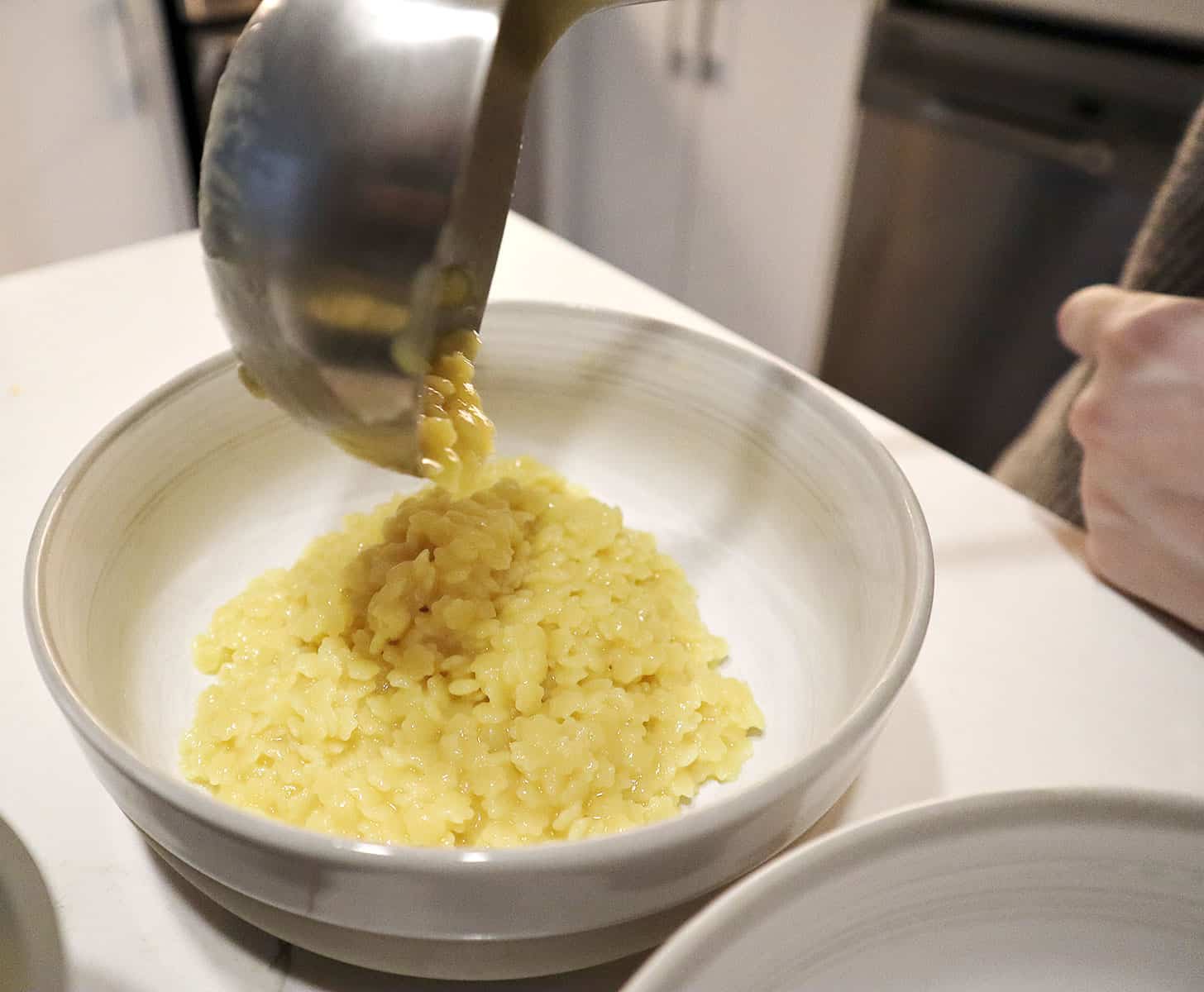
What is Pastina?
Pastina is a pasta dish, made with small pasta cooked in water or broth, until the liquid is absorbed and the pasta is cooked (no draining needed). Pastina in Italian means “Little Pasta”. Variations often include the addition of parmesan cheese, butter and egg.
Pastina is known as “Italian Penicillin”, as it is a traditional Italian cure-what-ails you food, much as chicken noodle soup is in North America. It’s also a often-used baby food!
Five Reasons to Love this Pastina with Egg Recipe!
- Pastina is a warm homemade meal you can enjoy any time of day or night.
- Pastina is actually quick to make (ready in less than 15 minutes!)
- It actually tastes good! What good is quick if it isn’t tasty?
- The egg emulsifies with the starches of the pasta, creating a creamy, velvety sauce.
- Pastina with egg brings some extra protein, nutrients and flavour to the bowl.
The Simple Ingredients
Any small-shaped pasta – Pastina literally means “little pasta” in Italian. Therefore, any small-shaped pasta will work in this recipe. I like Stelline (or Stellette) because of its cute star shape. (In Canada, look for Barilla™ Stelline or De Cecco™ Stellette). Acini di Pepe or Orzo would also work. Even slightly larger pasta shapes like Tubetti or Ditali can also be used. Do note that Barilla™ also makes a pasta labelled “Pastina” on the box, which is a very tiny star shape and creates a porridge-like finished dish. I prefer the larger Stelline star shape, for the extra texture.
Chicken or Vegetable Broth – the broth in this recipe can make a big difference in the finished dish. First, make sure you like the taste, since it will highly influence the taste of the final dish. Secondly, some broth may produce an overly salty finished dish, as the broth reduces as it cooks and concentrates the saltiness. A low-sodium broth would be a great choice to avoid this (then add additional salt at the end, if needed) or you can also dilute regular broth with 1/4 or 1/2 water to reduce the sodium levels.
No broth? You can use all water in place of broth, just be sure to generously salt the dish at the end of cooking, for flavour.
Butter – Salted or unsalted butter would work in this recipe. If using unsalted butter, you may want to taste for salt at the end of cooking.
Egg – While the egg in this recipe adds creaminess and protein to the recipe, it can be omitted if desired.
Parmesan cheese – or Pecorino, if you prefer.
Tips for Making Pastina
- Mixing the Parmesan cheese into the egg prevents it from clumping together and makes it easier to emulsify into a creamy sauce.
- Adding a few spoons of the hot Pastina to the egg mixture before adding it to the Pastina helps temper the eggs and prevents scrambling the egg (and the dreaded white bits) when it comes into contact with the hot pan.
- Adding the butter to the Pastina before the egg mixture allows the Pastina to cool slightly, further preventing the egg from scrambling.
- When adding the butter and egg mixture to the Pastina, it is important to stir vigorously to emulsify the ingredients with the starchy broth. This is an essential step to achieving a creamy sauce.
- If scaling the recipe up or down, note that a smaller batch may need more broth and a larger batch may need less broth. The general ratio for Pastina is 4 to 1 broth to pasta (as in the 1X recipe below). For a very smaller batch (1/2X), I suggest 5 to 1 and for or a larger batch (2X), it’s more like 3 to 1. Keep this in mind when scaling the recipe.
- Be sure to taste taste and make sure the pasta is cooked before adding the butter and egg. If it’s still a little undercooked, add a bit of hot water to the pan and continue cooking until the pasta is al dente.
Step-by-Step Photos
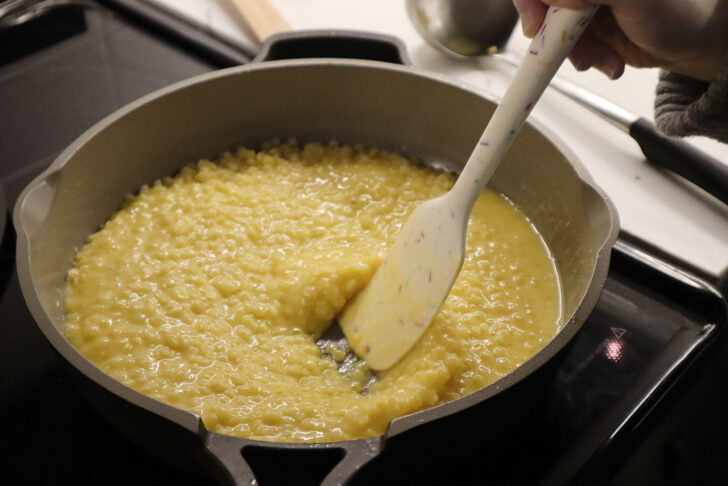
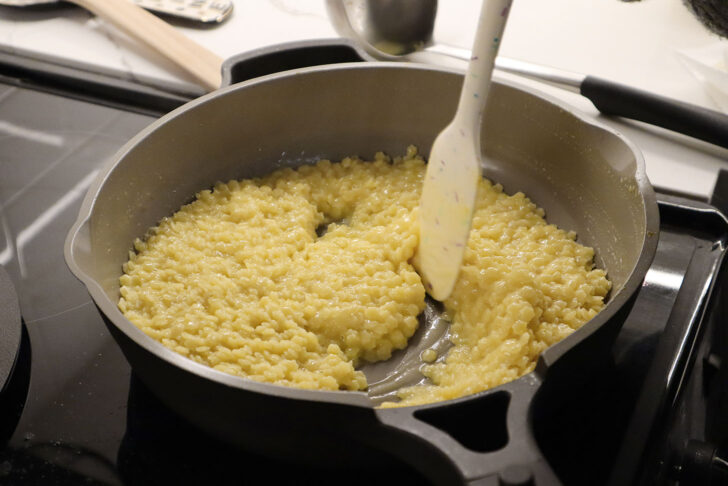
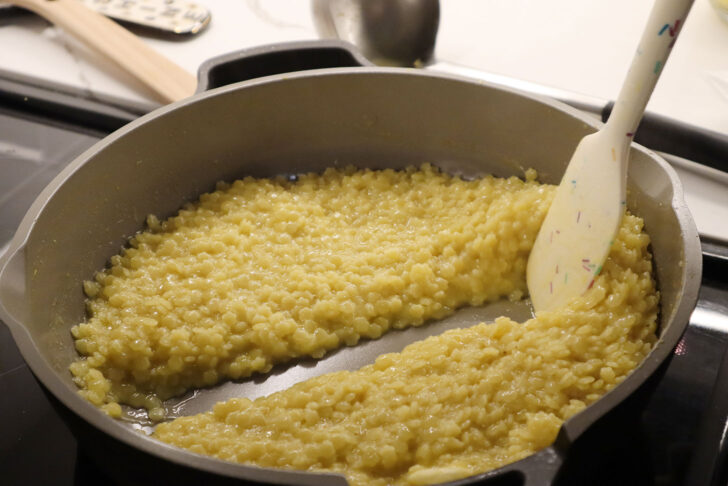
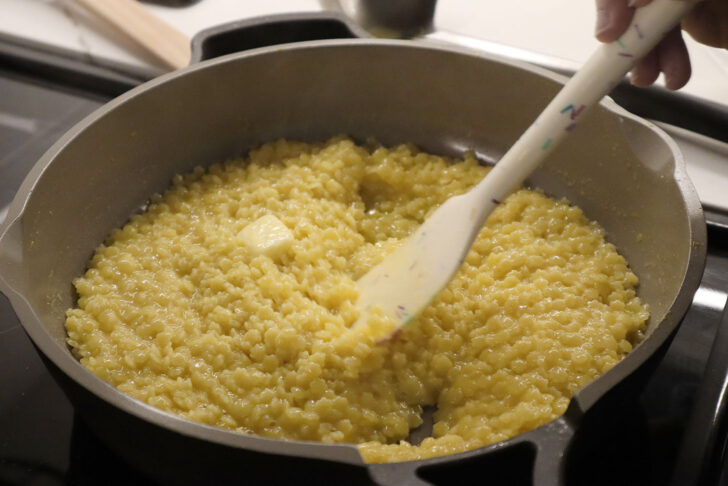
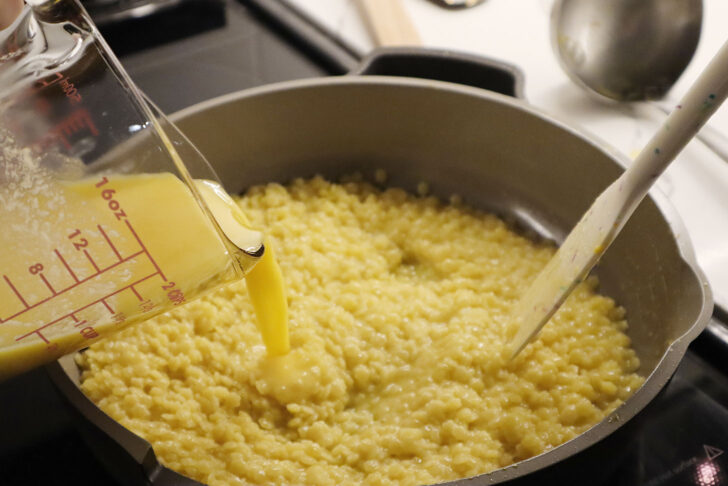
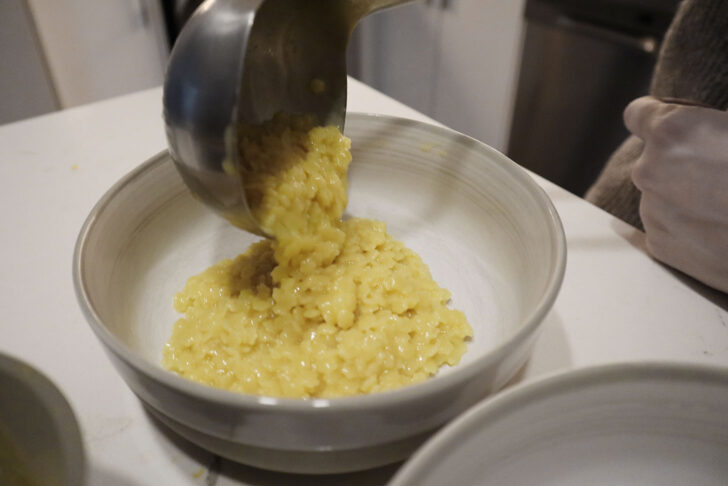
Variations
- Looking for a Pastina recipe without egg? You can simply omit it from this recipe without issue.
- Feel free to add veg to Pastina. Fresh or frozen peas are a great addition, but just about any vegetable will work.
- Add some cubed, cooked chicken for extra protein.
- Use more broth to make more of a soup (Pastina en Brodo).
- Channel classic pasta flavours by using bacon and cheese (Carbonara) or Cacio e Pepe style, with cheese and lots of black pepper.
For a Tomato Pastina: (Pastina Risottata), saute a bit of garlic in olive oil. Add 4 teaspoons of the tube kind of double-concentrated tomato paste (for the 1X recipe) and cook briefly until it starts to brown. Continue with base recipe as written, by adding the broth and heating before adding the pasta. You can use the egg or omit, as you like.
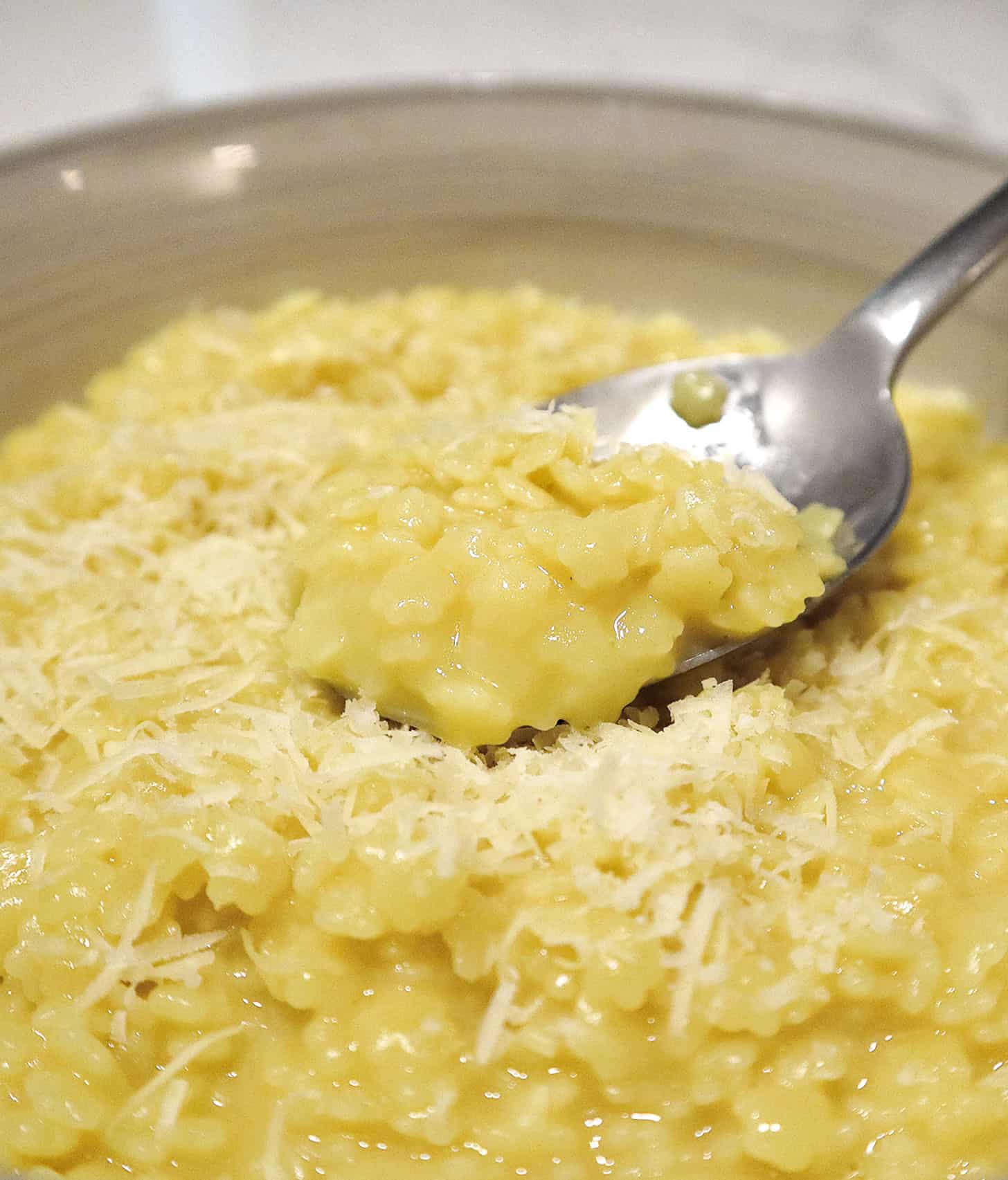
Storing and Reheating
Pastina can be stored in the fridge and reheated on the stovetop or microwave. You may have to add a small amount of water when reheating to loosen it up, as the pasta will absorb any excess broth during storage.
Want to save this recipe?
Enter your email & I’ll send it to your inbox. Plus, get great new recipes from me every week!
By submitting this form, you consent to receive emails from Seasons and Suppers.
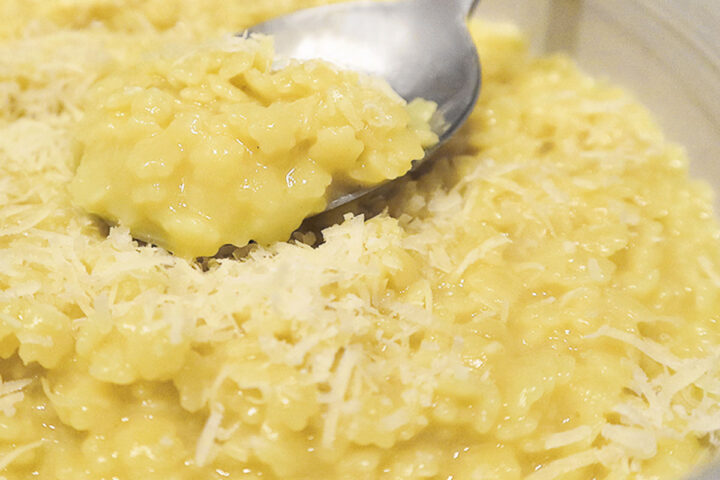
Get the Recipe: Pastina with Egg and Cheese
Ingredients
- 2 cups chicken or vegetable broth, low-sodium recommended (or water will also work)
- ½ cup small pasta (Pastina), such as star-shaped Stelline or Stellette or see Note 1 below for more options
- 1 Tablespoon butter, cold
- 2 Tablespoons freshly grated parmesan, (plus more for topping)
- 1 egg
To serve
- Freshly grated parmesan
- Freshly ground black pepper
- A drizzle of olive oil
Instructions
- Bring the chicken broth to a simmer in a shallow pot over hight heat. (A non-stick skillet works perfectly). Reduce heat to medium high once simmering.
- Add the Pastina to the broth and cook, stirring regularly to ensure it doesn’t stick to the bottom of the pan.
- While the Pastina is cooking, crack one egg in the same measuring cup used for the broth and whisk lightly with a fork until homogeneous.
- Add the parmesan to the egg and whisk until combined. Set aside.
- Simmer the broth until the Pastina is cooked all the way through and about 90% of the broth has been absorbed. (*When you run a spoon through the Pastina, it should leave an empty path that only very slowly fills back in like lava flowing). Taste test the pasta for done-ness. If it is not quite cooked, add a Tablespoon or two more broth or water, as needed, and continue cooking until pasta is al dente.
- Once the pasta is done, remove the pot from the heat, add the butter and stir vigorously until it has melted and emulsified with the remaining broth. Very slowly add two spoonfuls of the hot Pastina into the egg mixture while stirring together vigorously while adding. (This process raises the temperature of the egg closer to the temperature of the Pastina and will ensure that the egg doesn't scramble when you add it to the hot Pastina.)
- Add the egg mixture to the Pastina and stir vigorously to create a creamy sauce.
- Taste and season with additional salt, if needed.
- Ladle into bowls and serve with more freshly grated parmesan. You can optionally serve it with freshly ground black pepper and/or a drizzle of olive oil.
Notes
More Pasta Recipes to Love!
Hi! I’m Jennifer, a home cook schooled by trial and error and almost 40 years of getting dinner on the table! I love to share my favourite recipes, both old and new, together with lots of tips and tricks to hopefully help make your home cooking enjoyable, stress free, rewarding and of course, delicious!


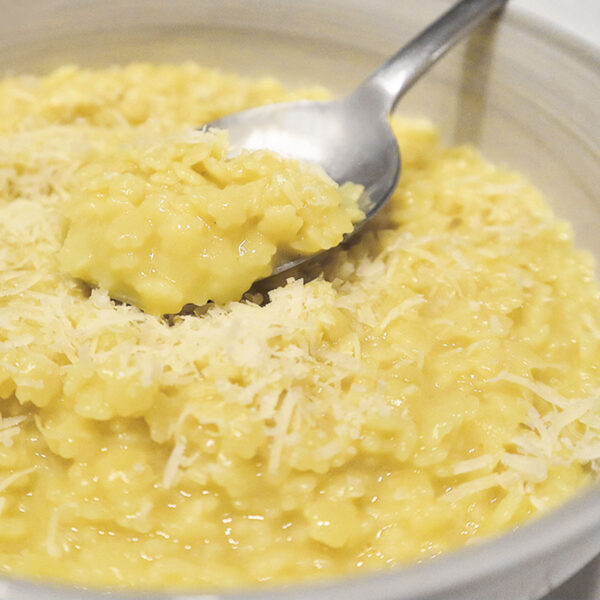

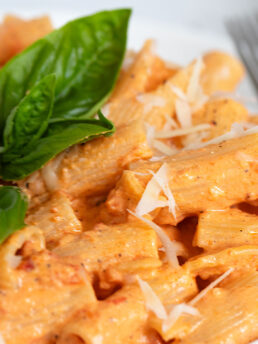
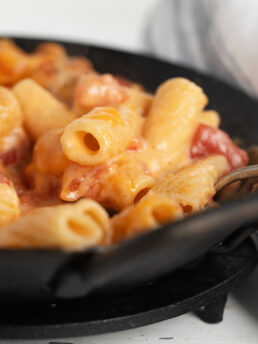

Came across your recipe which made me smile. Fond memories.
The only time my brother and I had pastina was when we were sick.
Mom would make it similarly but would use olive oil instead of butter.
It always did the trick. I still make it when I don’t feel well (got me through vid!). Thanks for the smile :)
Amazing!!! I have been looking for recipe close to my nanas and I think this is it! Absolutely delicious and my 8 month old loved it as well!!! Thank you so much
So glad to hear, Tiffani :) Thanks so much!
This was so good! I have never had it before so I don’t have anything to compare it to, but it was delicious and easy to make. I used the Mexican La Moderna Estrella pasta because that’s all I had and it worked well. Simple, but tasty and surprising filling. Thanks for the recipe!
So glad you enjoyed it, Jenny :) It’s a great, back-pocket recipe for a quick and comforting bowl. Thanks!
This looks good, Jennifer! Comfort food! If you can believe this, I literally just read (just before I scrolled to your newsletter), that they’ve stopped making pastina. I’ve never used it, nor do I think I’ve ever noticed it in the grocery stores. The brand they were referring to was Ronzoni. I’m in Ontario too. Where do you get yours and what brand is it?
Hi Colleen, look for Barilla “Stelline” or De Cecco “Stellette”. The Barilla Stelline is on the shelf at my small-town PC/Independent grocery store, so I suspect it’s easily found. You may see a Barilla pasta that is actually labelled “Pastina”, but that’s not the best option, in my opinion. It’s very tiny and makes a porridge-like pastina. It would be great for baby food, but I prefer the extra texture of the larger star shape.
Ok..thanks so much Jennifer..I just happen to have a PC/Independent grocery store 15 minutes from my house. I shall check that out!
This was our “baby food” fed to us in the 50’s by our 1st generation Italian mother. Who ate the same baby food herself. No Cream of Wheat/Rice for us!!
Lol! Yes, it’s been a staple for a lot of kids, for sure.
Pure comfort food! It kind of tastes like Kraft Dinner in the best possible way!
I agree, Carolyn! It does hit the spot :) Thanks!